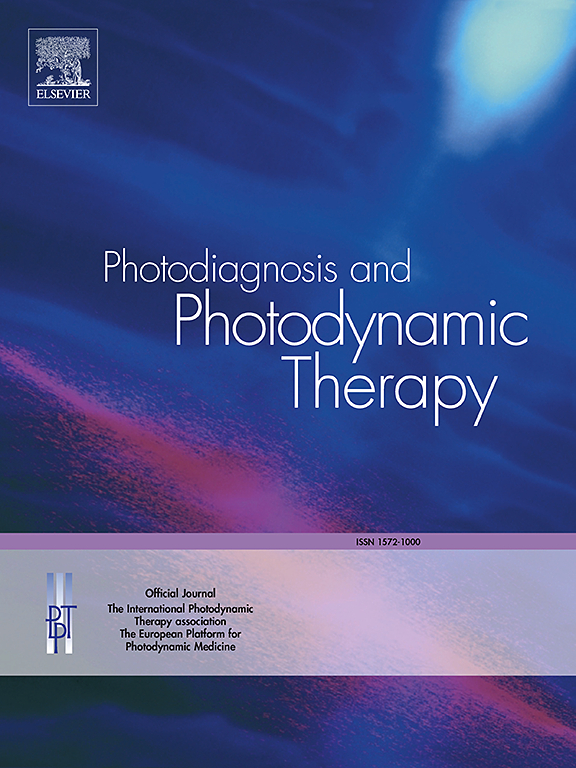超声室结合光动力疗法可抑制牙齿装置上细菌的生长。
IF 3.1
3区 医学
Q2 ONCOLOGY
引用次数: 0
摘要
背景:光动力疗法是一种结合光能和无毒光敏剂的两阶段治疗,增强了对细菌感染的治疗。在这种情况下,本研究评估了一种新的专利装置,称为超声光动力灭活装置(UPID),它使用光动力疗法对假体支架(PBs)和原型手术导板(psg)进行微生物灭活。方法:采用100 μM/L亚甲基蓝溶液菌悬液(3 × 108 CFU/mL)污染仪器20 min,然后用红色发光二极管(660 nm)照射(0.30 J/cm2) 20 min,对白色念珠菌ATCC 10231、金黄色葡萄球菌ATCC 25923和大肠杆菌ATCC 25922三种微生物进行光动力失活分析。psg包括30分钟(0.45 J/cm2)照射组和0.2%过氧乙酸对照组,在两个20分钟时间点进行评估。微生物抑制作用通过计算菌落形成单位(CFU)的数量来评估,并通过使用Shapiro-Wilk, Mann-Whitney-U和Kruskal-Wallis检验评估数据,在5%的显著性水平下进行评估。结果:所有实验处理均显著降低log CFU/mL。与阳性对照相比,UPID促进了显著的微生物减少(p < 0.001)。此外,过氧乙酸治疗PSG比PDT更有效(p < 0.001)。然而,20分钟后,两种处理都能保护表面材料不受细菌生长的影响。结论:该装置对PB和PSG有较好的抑菌效果,为生物医学器械的无毒性消毒提供了一种新技术。本文章由计算机程序翻译,如有差异,请以英文原文为准。
Ultrasonic chamber combined with photodynamic therapy inhibits bacterial growth on dental devices
Background
Photodynamic therapy is a two-stage treatment that combines light energy with a photosensitizer, and enhances the treatment against bacterial infections. In this context, the present study evaluated a newly patented device, called an ultrasonic photodynamic inactivation device (UPID), which performs microbial inactivation using photodynamic therapy for both prosthetic braces (PBs) and prototyped surgical guides (PSGs).
Methods
Photodynamic inactivation was analyzed by contaminating the instruments with bacterial suspensions (3 × 108 CFU/mL) of 100 µM/L methylene blue solution for 20 min, followed by irradiation (0.30 J/cm2) with red light-emitting diode (660 nm) for 20 min, on three types of microorganisms: Candida albicans ATCC 10,231, Staphylococcus aureus ATCC 25,923 and Escherichia coli ATCC 25,922. The PSGs included a group with irradiation for 30 min (0.45 J/cm2), and a control group with 0.2 % peracetic acid, evaluated at both 20-minute time points. Microbial inhibition was assessed by counting the number of colony-forming units (CFU), and by the data evaluated using the Shapiro-Wilk, Mann-Whitney-U, and Kruskal-Wallis tests, at a 5 % significance level.
Results
All experimental treatments showed significant reduction in log CFU/mL. The UPID promoted a significant microbial reduction (p < 0.001), compared with the positive control. In addition, peracetic acid was more effective than PDT for the PSG (p < 0.001). However, after 20 min, both treatments protected the surface material against bacterial growth.
Conclusion
The device proved effective for microbial inhibition of PB and PSG, thus proposing a new technique for the non-toxic disinfection of biomedical devices.
求助全文
通过发布文献求助,成功后即可免费获取论文全文。
去求助
来源期刊

Photodiagnosis and Photodynamic Therapy
ONCOLOGY-
CiteScore
5.80
自引率
24.20%
发文量
509
审稿时长
50 days
期刊介绍:
Photodiagnosis and Photodynamic Therapy is an international journal for the dissemination of scientific knowledge and clinical developments of Photodiagnosis and Photodynamic Therapy in all medical specialties. The journal publishes original articles, review articles, case presentations, "how-to-do-it" articles, Letters to the Editor, short communications and relevant images with short descriptions. All submitted material is subject to a strict peer-review process.
 求助内容:
求助内容: 应助结果提醒方式:
应助结果提醒方式:


